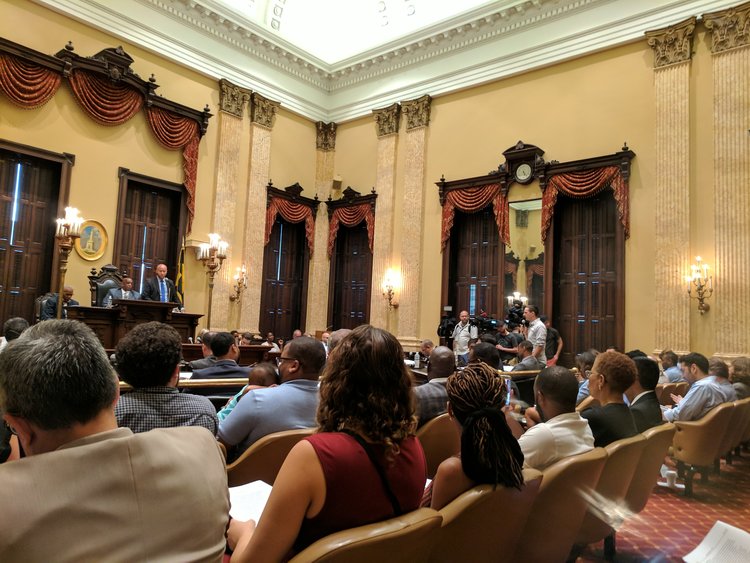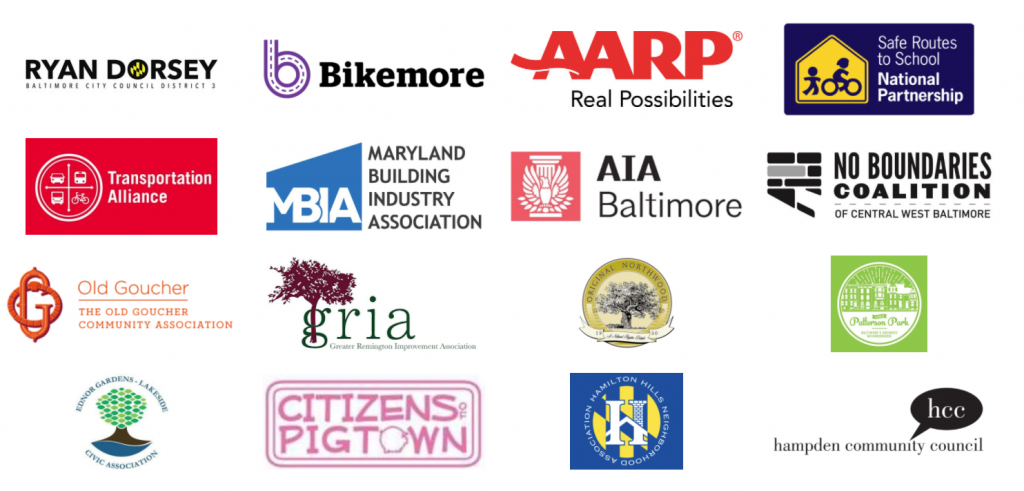
News
By Smart Growth America, March 19, 2018
Last November, the National Complete Streets Coalition adopted a new and improved policy framework for grading Complete Streets policies. Our revamped Elements of a Complete Streets Policy raises the bar by calling for stronger commitments to equity and implementation. To celebrate the new framework, this year we're highlight some of the best Complete Streets initiatives, projects, and champions around the country in lieu of our usual annual Best Complete Streets Policies report. Between now and the release of the full report on March 21, we'll be profiling one winning initiative each week. Last week's profile featured VELO Bloomfield's community engagement efforts in North Jersey. This week: Councilman Ryan Dorsey's campaign to adopt a Complete Streets ordinance with binding requirements for equity in Baltimore, MD.
---
 Councilman Ryan Dorsey introduces Baltimore's Complete Streets ordinance at a City Council meeting. Photo courtesy of Bikemore.
Councilman Ryan Dorsey introduces Baltimore's Complete Streets ordinance at a City Council meeting. Photo courtesy of Bikemore.
Location: Baltimore, MD
Initiative: Complete Streets Champion Ryan Dorsey
Councilman Ryan Dorsey, in collaboration with the advocacy organization Bikemore, drafted a groundbreaking Complete Streets ordinance for the City of Baltimore. The Complete Streets ordinance, if adopted, will introduce stringent, binding requirements to proactively reduce disparities in community engagement, project delivery, and performance measurements. The proposed ordinance is the result of a yearlong stakeholder engagement process that has built a broad coalition of supporters to oversee the adoption and implementation of this ambitious ordinance.
Baltimore has implemented three of the key implementation steps for Complete Streets initiatives.

Baltimore passed a Complete Streets resolution back in 2010, but the policy was non-binding, had no enforceable steps for implementation, and didn’t address equity in any capacity. Councilman Dorsey recognized that a more equitable distribution of investments in Baltimore’s transportation system required a stronger, binding Complete Streets ordinance designed to specifically prioritize underserved communities. He teamed up with Bikemore, an organization that advocates for policies to support walkable, bikeable, mixed-use neighborhoods. Together, Councilman Dorsey and Bikemore drafted a new Complete Streets ordinance that sets binding equity requirements. They also launched an ambitious outreach effort to build a broad coalition to support the ordinance’s passage and implementation.
Building a coalition
To successfully pass an ordinance with strong, binding requirements for equity, Councilman Dorsey and Bikemore knew they would need widespread support from a broad coalition. Beginning in 2016, they kicked off a campaign to craft the language of the ordinance and advocate for its adoption. They attended over 50 stakeholder meetings resulting in a strong coalition that includes dozens of local, community-based organizations and national partners.
 Coalition members in support of Baltimore's Complete Streets ordinance. Photo courtesy of Bikemore.
Coalition members in support of Baltimore's Complete Streets ordinance. Photo courtesy of Bikemore.
Setting the stage for Complete Streets implementation
In July of 2017, Councilman Dorsey formally introduced Council Bill 17-0102 to the Baltimore City Council. The ordinance calls for the development of a Complete Streets design and implementation manual that includes processes for prioritizing, designing, and delivering Complete Streets projects on different types of streets. It also outlines a community engagement process to specifically empower disenfranchised voices by requiring the city to proactively identify and overcome barriers to engagement related to race, income, age, disability, language proficiency, and vehicle access. To ensure that underserved communities are prioritized when choosing which projects to fund, the bill also mandates an equity gap analysis that examines how proposed projects will impact vulnerable communities. Finally, the bill establishes an annual reporting requirement that includes crash data, transit on-time performance, commute times for multiple transportation options, how often people use different modes of transportation, and new Complete Streets projects, all of which must be reported separately by race, income, vehicle access, and location. By including binding requirements for equity throughout the project selection, development, implementation, and evaluation processes as well as requiring extensive data collection, Baltimore’s ordinance could create the foundation for a Complete Streets program where equity is consistently at the forefront.
Lessons learned
Adopting a Complete Streets policy is the first step to embedding a Complete Streets approach in routine transportation planning. Getting this initial step right can set the stage for better processes and projects. With Council Bill 17-0102, Councilman Dorsey, Bikemore, and their entire coalition have set an ambitious new precedent for how to craft equitable Complete Streets policies, processes, and programs. Equity is more than just a policy goal in Baltimore’s proposed ordinance; it is the core requirement of the city’s entire Complete Streets program from initial concept to final evaluation. The ordinance is a first step toward correcting systemic underinvestment in transportation infrastructure in communities of color. By patiently building a strong, broad coalition, Councilman Dorsey and Bikemore were able to introduce more ambitious, stringent equity requirements that might not otherwise have been politically viable.
Baltimore’s Complete Streets ordinance embodies the themes of equity and implementation in the National Complete Streets Coalition’s new and improved policy framework. Other jurisdictions can and should adapt and build upon the model of community engagement used to draft Baltimore’s ordinance, as well as their primary focus on reducing safety and accessibility disparities by embedding equity considerations into every step of the program.
Related News

© 2025 Smart Growth America. All rights reserved
Site By3Lane Marketing










